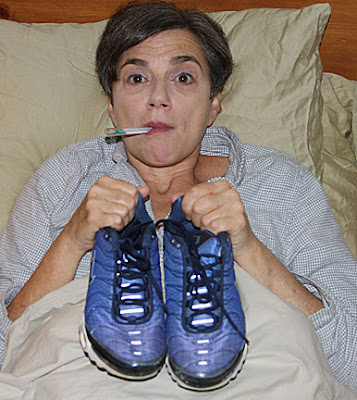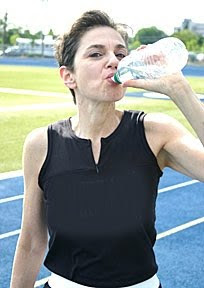 When Spring is just around the corner I get lots of emails saying, “ I’d like to get a pair of new sneakers. What type of athletic shoes should I buy for walking or jogging outside? ”
When Spring is just around the corner I get lots of emails saying, “ I’d like to get a pair of new sneakers. What type of athletic shoes should I buy for walking or jogging outside? ”
There’s no one answer. There are just about as many types and brands of new sneakers as there are feet. Yours are unique, but one rule applies to all. This is how to treat your feet!
New Sneakers: How To Choose Your Next Pair
New sneakers need to feel great right out of the box. No break-in! They also need to be sport specific. Stick with a shoe that’s designed for your particular activity.
So how do you pick a shoe? Ask your feet.
Check out the regular shoes you have at home. Where are they worn down?
If they’re worn on the inside edge you have low arches and point your feet inward. Try athletic shoes with good arch support.
If your shoes wear on the outside you point your feet outward. You need a shoe with more cushioning and good lateral support.
If you have even wear on your heels, you walk and run with your feet mostly straight ahead. You can buy any quality shoe that feels good on your foot.
What is a quality shoe anyway?
- Heel box needs to be on the stiff side and comfortably keep your heel from popping out
- The toe box needs to flex but not so much as to let your foot twist. Your big toe shouldn’t hit the front of the shoe
- The upper needs to surround your foot and give it the amount of comfortable support your particular foot needs
- The shoe should have enough cushioning to absorb impact but not so much as to make it unstable
- You should be able to get a good pair for under a hundred bucks
But what about toning shoes? The principle behind these is that the design of the shoe’s sole keeps you off balance; and because you’re always working to keep your balance, you work harder, burn more calories, use your muscles more and therefore get a better workout and a more toned body.
I can’t speak first hand about these because I’ve never worn a pair. But I do have a close friend who swears by them. Her enthusiasm peaked my curiosity and got me Goggling. I found a study by the American Council on Exercise. This is the non-profit organization that tests and certifies fitness instructors throughout the US. They tested all the major brands of toning shoes against regular athletic shoes.
Their study found no significant difference between the Toning shoes and the regular shoes.
The bottom line is there is no silver bullet. A lot of this is trial and error. It’s all about the fit; and if the shoe fits, it will be a treat for your feet when you wear it.
CLICK HERE FOR MORE INFO ON MIRABAI”S ONLINE CLUB:

For more health and fitness information and at home exercise programs please visit www.mirabaiholland.com
EASE IN, BECOME MOBILE, GET STRONG, LIVE LONG!
To View All Products: Click Here 
Follow Mirabai Holland on
























 Hydration Tips. Be water safe this summer!
Hydration Tips. Be water safe this summer!



 NEW! MEMBERSHIP ON-DEMAND WORKOUT CLUB
NEW! MEMBERSHIP ON-DEMAND WORKOUT CLUB 


 “My Dad had severe rheumatoid arthritis. I designed a Moving Free® exercise program for him and worked with him for several months. It brought him so much relief that he brought the program to the attention of the National Arthritis Foundation. I was proud to become one of their exercise consultants.”
“My Dad had severe rheumatoid arthritis. I designed a Moving Free® exercise program for him and worked with him for several months. It brought him so much relief that he brought the program to the attention of the National Arthritis Foundation. I was proud to become one of their exercise consultants.”